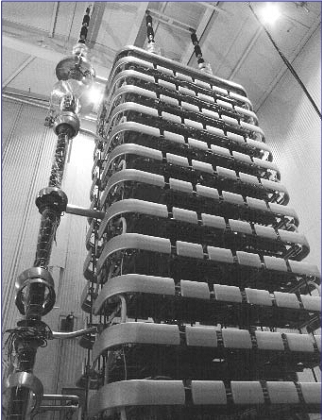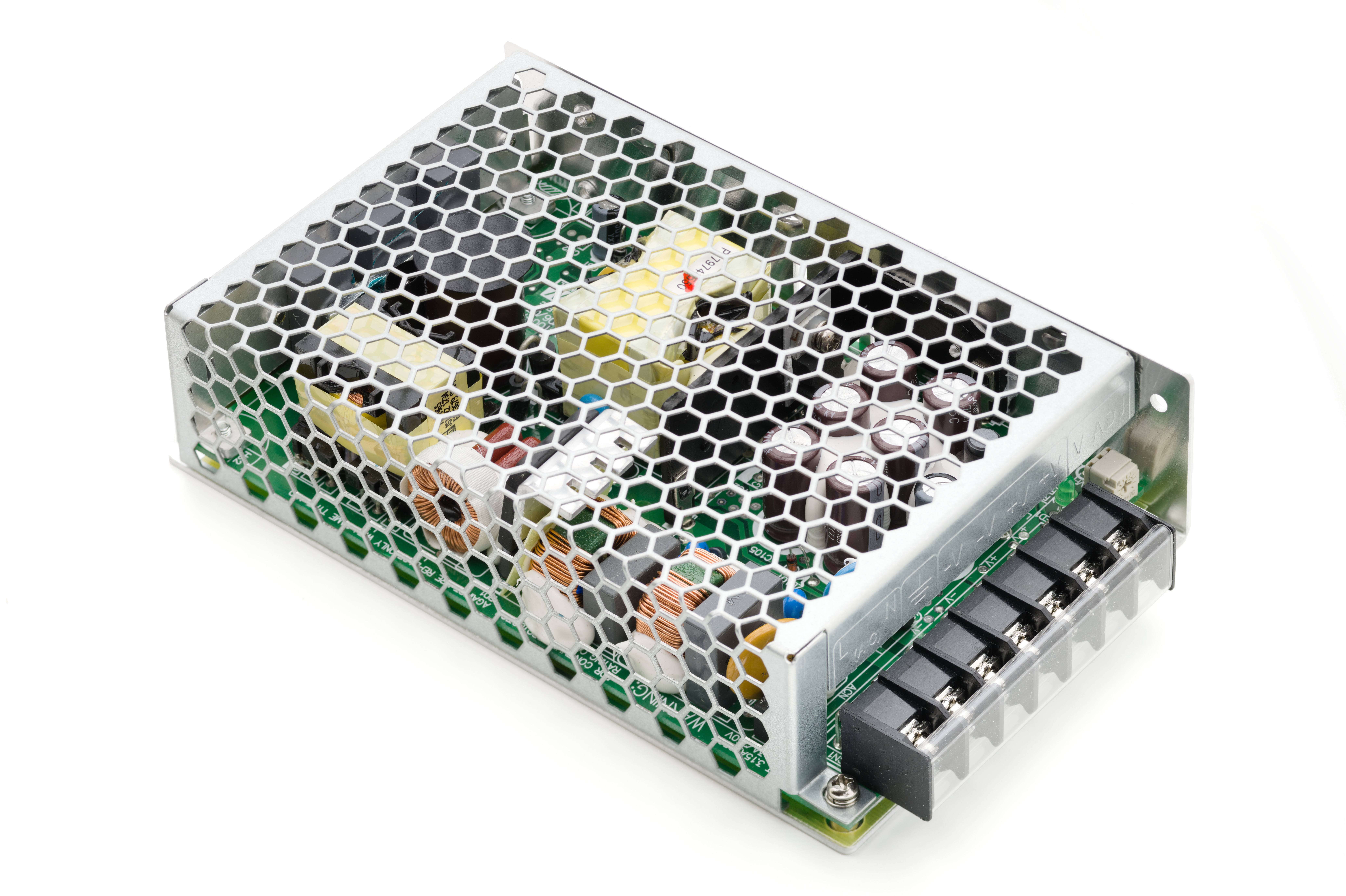|
Inverter
A power inverter, inverter, or invertor is a power electronic device or circuitry that changes direct current (DC) to alternating current (AC). The resulting AC frequency obtained depends on the particular device employed. Inverters do the opposite of rectifiers which were originally large electromechanical devices converting AC to DC. The input voltage, output voltage and frequency, and overall power handling depend on the design of the specific device or circuitry. The inverter does not produce any power; the power is provided by the DC source. A power inverter can be entirely electronic or maybe a combination of mechanical effects (such as a rotary apparatus) and electronic circuitry. Static inverters do not use moving parts in the conversion process. Power inverters are primarily used in electrical power applications where high currents and voltages are present; circuits that perform the same function for electronic signals, which usually have very low currents and vol ... [...More Info...] [...Related Items...] OR: [Wikipedia] [Google] [Baidu] |
Power Electronics
Power electronics is the application of electronics to the control and conversion of electric power. The first high-power electronic devices were made using mercury-arc valves. In modern systems, the conversion is performed with semiconductor switching devices such as diodes, thyristors, and power transistors such as the power MOSFET and IGBT. In contrast to electronic systems concerned with the transmission and processing of signals and data, substantial amounts of electrical energy are processed in power electronics. An AC/DC converter (rectifier) is the most typical power electronics device found in many consumer electronic devices, e.g. television sets, personal computers, battery chargers, etc. The power range is typically from tens of watts to several hundred watts. In industry, a common application is the Adjustable-speed drive, variable speed drive (VSD) that is used to control an induction motor. The power range of VSDs starts from a few hundred watts and ends at ten ... [...More Info...] [...Related Items...] OR: [Wikipedia] [Google] [Baidu] |
Watt
The watt (symbol: W) is the unit of Power (physics), power or radiant flux in the International System of Units (SI), equal to 1 joule per second or 1 kg⋅m2⋅s−3. It is used to quantification (science), quantify the rate of Work (physics), energy transfer. The watt is named in honor of James Watt (1736–1819), an 18th-century Scottish people, Scottish inventor, mechanical engineer, and chemist who improved the Newcomen engine with his own Watt steam engine, steam engine in 1776, which became fundamental for the Industrial Revolution. Overview When an object's velocity is held constant at one meter per second against a constant opposing force of one Newton (unit), newton, the rate at which Work (physics), work is done is one watt. \mathrm. In terms of electromagnetism, one watt is the rate at which electrical work is performed when a current of one ampere (A) flows across an electrical potential difference of one volt (V), meaning the watt is equivalent to the vo ... [...More Info...] [...Related Items...] OR: [Wikipedia] [Google] [Baidu] |
Switched-mode Power Supply
A switched-mode power supply (SMPS), also called switching-mode power supply, switch-mode power supply, switched power supply, or simply switcher, is an electronic power supply that incorporates a switching regulator to electric power conversion, convert electrical power efficiently. Like other power supplies, a SMPS transfers power from a DC or AC source (often Mains electricity, mains power, see AC adapter) to DC loads, such as a personal computer, while converting voltage and Electric current, current characteristics. Unlike a linear power supply, the pass transistor of a switching-mode supply continually switches between low-dissipation, full-on and full-off states, and spends very little time in the high-dissipation transitions, which minimizes wasted energy. Voltage regulator, Voltage regulation is achieved by varying the ratio of on-to-off time (also known as duty cycle). In contrast, a linear power supply regulates the output voltage by continually dissipating power in t ... [...More Info...] [...Related Items...] OR: [Wikipedia] [Google] [Baidu] |
Root Mean Square
In mathematics, the root mean square (abbrev. RMS, or rms) of a set of values is the square root of the set's mean square. Given a set x_i, its RMS is denoted as either x_\mathrm or \mathrm_x. The RMS is also known as the quadratic mean (denoted M_2), a special case of the generalized mean. The RMS of a continuous function is denoted f_\mathrm and can be defined in terms of an integral of the square of the function. In estimation theory, the root-mean-square deviation of an estimator measures how far the estimator strays from the data. Definition The RMS value of a set of values (or a continuous-time waveform) is the square root of the arithmetic mean of the squares of the values, or the square of the function that defines the continuous waveform. In the case of a set of ''n'' values \, the RMS is : x_\text = \sqrt. The corresponding formula for a continuous function (or waveform) ''f''(''t'') defined over the interval T_1 \le t \le T_2 is : f_\text = \sqrt , and the R ... [...More Info...] [...Related Items...] OR: [Wikipedia] [Google] [Baidu] |
Square Wave
Square wave may refer to: *Square wave (waveform) A square wave is a non-sinusoidal waveform, non-sinusoidal periodic waveform in which the amplitude alternates at a steady frequency between fixed minimum and maximum values, with the same duration at minimum and maximum. In an ideal squar ... * Cross seas, also known as square waves {{Disambiguation ... [...More Info...] [...Related Items...] OR: [Wikipedia] [Google] [Baidu] |
Parallel Circuit
Terminal (electronics), Two-terminal components and electrical networks can be connected in series or parallel. The resulting electrical network will have two terminals, and itself can participate in a series or parallel Topology (electrical circuits), topology. Whether a two-terminal "object" is an electrical component (e.g. a resistor) or an electrical network (e.g. resistors in series) is a matter of perspective. This article will use "component" to refer to a two-terminal "object" that participates in the series/parallel networks. Components connected in series are connected along a single "electrical path", and each component has the same electric current through it, equal to the current through the network. The voltage across the network is equal to the sum of the voltages across each component. Components connected in parallel are connected along multiple paths, and each component has the same voltage across it, equal to the voltage across the network. The current throug ... [...More Info...] [...Related Items...] OR: [Wikipedia] [Google] [Baidu] |
Daisy Chain (electrical Engineering)
In electrical and electronic engineering, a daisy chain is a wiring scheme in which multiple devices are wired together in sequence or in a ring, similar to a Daisy garland, garland of daisy flowers. Daisy chains may be used for power, analog signals, digital data, or a combination thereof. The term ''daisy chain'' may refer either to large scale devices connected in series, such as a series of power strips plugged into each other to form a single long line of strips, or to the wiring patterns embedded inside of devices. Other examples of devices which can be used to form daisy chains are those based on Universal Serial Bus (USB), FireWire, Thunderbolt (interface), Thunderbolt and Ethernet cables. Signal transmission For analog signals, connections usually consist of a simple Bus (computing), electrical bus and, especially in the case of a Signal chain (signal processing chain), chain of many devices, may require the use of one or more repeaters or amplifiers within the ch ... [...More Info...] [...Related Items...] OR: [Wikipedia] [Google] [Baidu] |
Hertz
The hertz (symbol: Hz) is the unit of frequency in the International System of Units (SI), often described as being equivalent to one event (or Cycle per second, cycle) per second. The hertz is an SI derived unit whose formal expression in terms of SI base units is 1/s or s−1, meaning that one hertz is one per second or the Inverse second, reciprocal of one second. It is used only in the case of periodic events. It is named after Heinrich Hertz, Heinrich Rudolf Hertz (1857–1894), the first person to provide conclusive proof of the existence of electromagnetic waves. For high frequencies, the unit is commonly expressed in metric prefix, multiples: kilohertz (kHz), megahertz (MHz), gigahertz (GHz), terahertz (THz). Some of the unit's most common uses are in the description of periodic waveforms and musical tones, particularly those used in radio- and audio-related applications. It is also used to describe the clock speeds at which computers and other electronics are driven. T ... [...More Info...] [...Related Items...] OR: [Wikipedia] [Google] [Baidu] |
MOSFET
upright=1.3, Two power MOSFETs in amperes">A in the ''on'' state, dissipating up to about 100 watt">W and controlling a load of over 2000 W. A matchstick is pictured for scale. In electronics, the metal–oxide–semiconductor field-effect transistor (MOSFET, MOS-FET, MOS FET, or MOS transistor) is a type of field-effect transistor (FET), most commonly fabricated by the controlled oxidation of silicon. It has an insulated gate, the voltage of which determines the conductivity of the device. This ability to change conductivity with the amount of applied voltage can be used for amplifying or switching electronic signals. The term ''metal–insulator–semiconductor field-effect transistor'' (''MISFET'') is almost synonymous with ''MOSFET''. Another near-synonym is ''insulated-gate field-effect transistor'' (''IGFET''). The main advantage of a MOSFET is that it requires almost no input current to control the load current under steady-state or low-frequency conditions ... [...More Info...] [...Related Items...] OR: [Wikipedia] [Google] [Baidu] |


